本文共 6951 字,大约阅读时间需要 23 分钟。
阅读目录
监听器是JAVA Web开发中很重要的内容,其中涉及到的知识,可以参考下面导图:
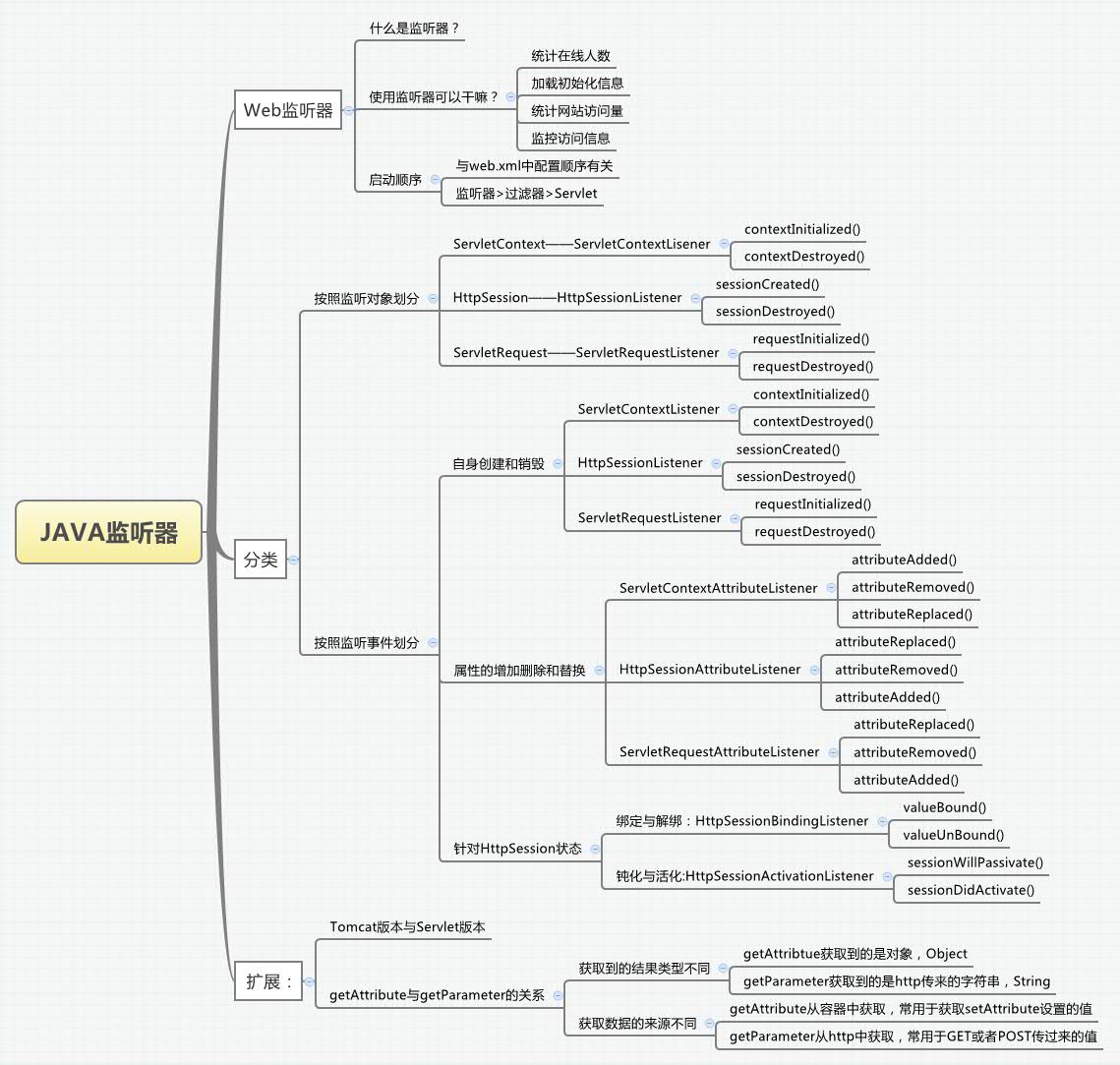
Web监听器
1 什么是web监听器?
web监听器是一种Servlet中的特殊的类,它们能帮助开发者监听web中的特定事件,比如ServletContext,HttpSession,ServletRequest的创建和销毁;变量的创建、销毁和修改等。可以在某些动作前后增加处理,实现监控。
2 监听器常用的用途
通常使用Web监听器做以下的内容:
统计在线人数,利用HttpSessionLisener
加载初始化信息:利用ServletContextListener
统计网站访问量
实现访问监控
3 接下里看看一个监听器的创建以及执行过程
首先需要创建一个监听器,实现某种接口,例如我想实现一个对在线人数的监控,可以创建如下的监听器:
public class MyListener implements HttpSessionListener{ private int userNumber = 0; public void sessionCreated(HttpSessionEvent arg0) { userNumber++; arg0.getSession().setAttribute("userNumber", userNumber); } public void sessionDestroyed(HttpSessionEvent arg0) { userNumber--; arg0.getSession().setAttribute("userNumber", userNumber); } } 然后在web.xml中配置该监听器,在web-app中添加:
com.test.MyListener
在JSP中添加访问人数:
在线人数:<%=session.getAttribute("userNumber") %> 当我使用我的浏览器访问时,执行结果如下:

当打开另一个浏览器访问时:

由于打开另一个浏览器访问,相当于另一个会话,因此在线人数会增加。
对于3.0版本的Servlet来说,还支持使用注解的方式进行配置。
那么接下来看看都有哪些监听器以及方法吧!
监听器的分类
1 按照监听的对象划分:
按照监听对象的不同可以划分为三种:
ServletContext监控:对应监控application内置对象的创建和销毁。
当web容器开启时,执行contextInitialized方法;当容器关闭或重启时,执行contextDestroyed方法。
实现方式:直接实现ServletContextListener接口:
public class MyServletContextListener implements ServletContextListener{ public void contextDestroyed(ServletContextEvent sce) { } public void contextInitialized(ServletContextEvent sce) { } } HttpSession监控:对应监控session内置对象的创建和销毁。
当打开一个新的页面时,开启一个session会话,执行sessionCreated方法;当页面关闭session过期时,或者容器关闭销毁时,执行sessionDestroyed方法。
实现方式:直接实现HttpSessionListener接口:
public class MyHttpSessionListener implements HttpSessionListener{ public void sessionCreated(HttpSessionEvent arg0) { } public void sessionDestroyed(HttpSessionEvent arg0) { } } ServletRequest监控:对应监控request内置对象的创建和销毁。
当访问某个页面时,出发一个request请求,执行requestInitialized方法;当页面关闭时,执行requestDestroyed方法。
实现方式,直接实现ServletRequestListener接口:
public class MyServletRequestListener implements ServletRequestListener{ public void requestDestroyed(ServletRequestEvent arg0) { } public void requestInitialized(ServletRequestEvent arg0) { } }
2 按照监听事件划分:
2.1 监听事件自身的创建和销毁:同上面的按对象划分。
2.2 监听属性的新增、删除和修改:
监听属性的新增、删除和修改也是划分成三种,分别针对于ServletContext、HttpSession、ServletRequest对象:
ServletContext,实现ServletContextAttributeListener接口:
通过调用ServletContextAttribtueEvent的getName方法可以得到属性的名称。
public class MyServletContextAttrListener implements ServletContextAttributeListener{ public void attributeAdded(ServletContextAttributeEvent hsbe) { System.out.println("In servletContext added :name = "+hsbe.getName()); } public void attributeRemoved(ServletContextAttributeEvent hsbe) { System.out.println("In servletContext removed :name = "+hsbe.getName()); } public void attributeReplaced(ServletContextAttributeEvent hsbe) { System.out.println("In servletContext replaced :name = "+hsbe.getName()); } } HttpSession,实现HttpSessionAttributeListener接口:
public class MyHttpSessionAttrListener implements HttpSessionAttributeListener{ public void attributeAdded(HttpSessionBindingEvent hsbe) { System.out.println("In httpsession added:name = "+hsbe.getName()); } public void attributeRemoved(HttpSessionBindingEvent hsbe) { System.out.println("In httpsession removed:name = "+hsbe.getName()); } public void attributeReplaced(HttpSessionBindingEvent hsbe) { System.out.println("In httpsession replaced:name = "+hsbe.getName()); } } ServletRequest,实现ServletRequestAttributeListener接口:
public class MyServletRequestAttrListener implements ServletRequestAttributeListener{ public void attributeAdded(ServletRequestAttributeEvent hsbe) { System.out.println("In servletrequest added :name = "+hsbe.getName()); } public void attributeRemoved(ServletRequestAttributeEvent hsbe) { System.out.println("In servletrequest removed :name = "+hsbe.getName()); } public void attributeReplaced(ServletRequestAttributeEvent hsbe) { System.out.println("In servletrequest replaced :name = "+hsbe.getName()); } } 2.3 监听对象的状态:
针对某些POJO类,可以通过实现HttpSessionBindingListener接口,监听POJO类对象的事件。例如:
public class User implements HttpSessionBindingListener,Serializable{ private String username; private String password; public String getUsername() { return username; } public void setUsername(String username) { this.username = username; } public String getPassword() { return password; } public void setPassword(String password) { this.password = password; } public void valueBound(HttpSessionBindingEvent hsbe) { System.out.println("valueBound name: "+hsbe.getName()); } public void valueUnbound(HttpSessionBindingEvent hsbe) { System.out.println("valueUnbound name: "+hsbe.getName()); } } Session数据的钝化与活化:
由于session中保存大量访问网站相关的重要信息,因此过多的session数据就会服务器性能的下降,占用过多的内存。因此类似数据库对象的持久化,web容器也会把不常使用的session数据持久化到本地文件或者数据中。这些都是有web容器自己完成,不需要用户设定。
不用的session数据序列化到本地文件中的过程,就是钝化;
当再次访问需要到该session的内容时,就会读取本地文件,再次放入内存中,这个过程就是活化。
类似的,只要实现HttpSeesionActivationListener接口就是实现钝化与活化事件的监听:
public class User implements HttpSessionBindingListener,HttpSessionActivationListener,Serializable{ private String username; private String password; public String getUsername() { return username; } public void setUsername(String username) { this.username = username; } public String getPassword() { return password; } public void setPassword(String password) { this.password = password; } public void valueBound(HttpSessionBindingEvent hsbe) { System.out.println("valueBound name: "+hsbe.getName()); } public void valueUnbound(HttpSessionBindingEvent hsbe) { System.out.println("valueUnbound name: "+hsbe.getName()); } public void sessionDidActivate(HttpSessionEvent hsbe) { System.out.println("sessionDidActivate name: "+hsbe.getSource()); } public void sessionWillPassivate(HttpSessionEvent hsbe) { System.out.println("sessionWillPassivate name: "+hsbe.getSource()); } } Servlet版本与Tomcat版本
首先看一下Tomcat官网给出的匹配:
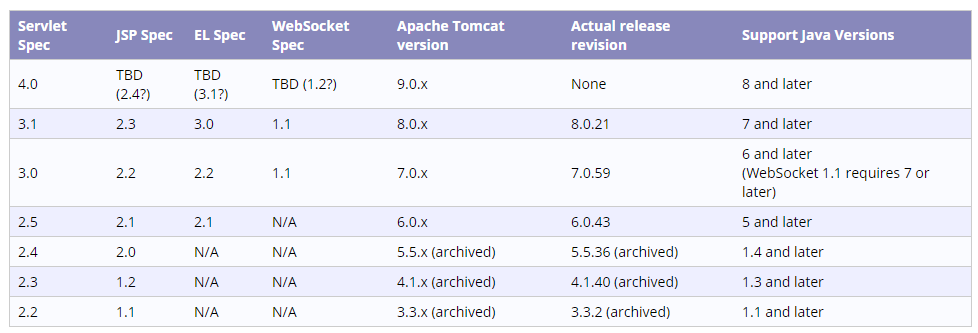
如果版本不匹配,那么tomcat是不能发布该工程的,首先看一下版本不匹配时,会发生什么!
我试图创建一个web工程,并且选取了Servlet3.0版本:
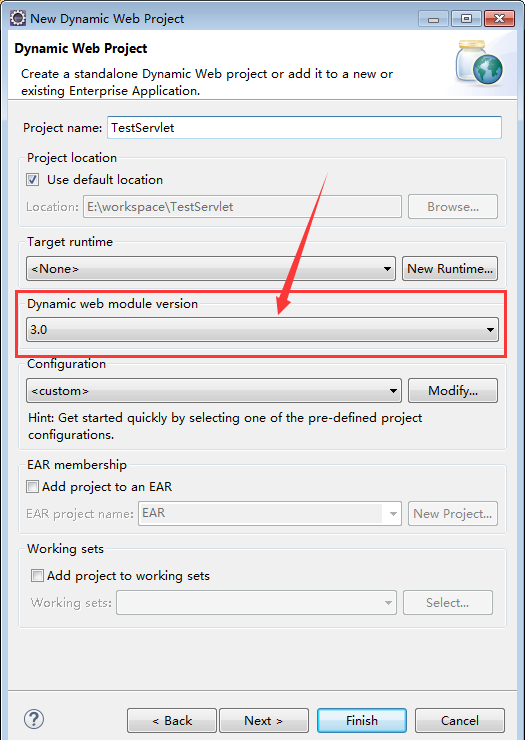
然后我想要在tomcat6中发布,可以看到报错了!
JDK版本不对....这是在平时开发如果对Servlet不熟悉的web新手,常犯的错误。
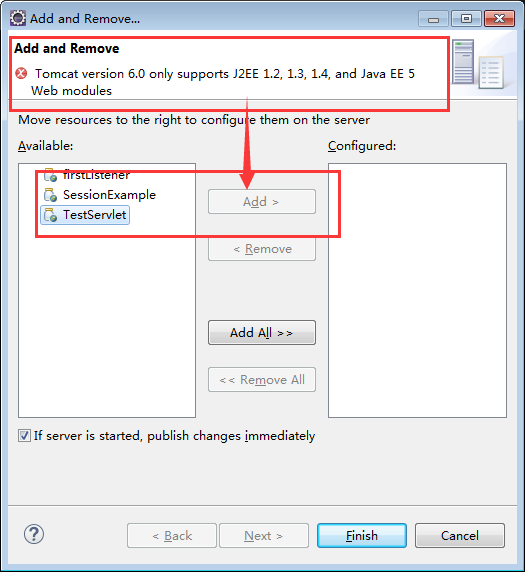
解决方法:
1 在创建时,直接发布到Tomcat容器中,此时Servlet仅仅会列出Tomcat支持的版本:
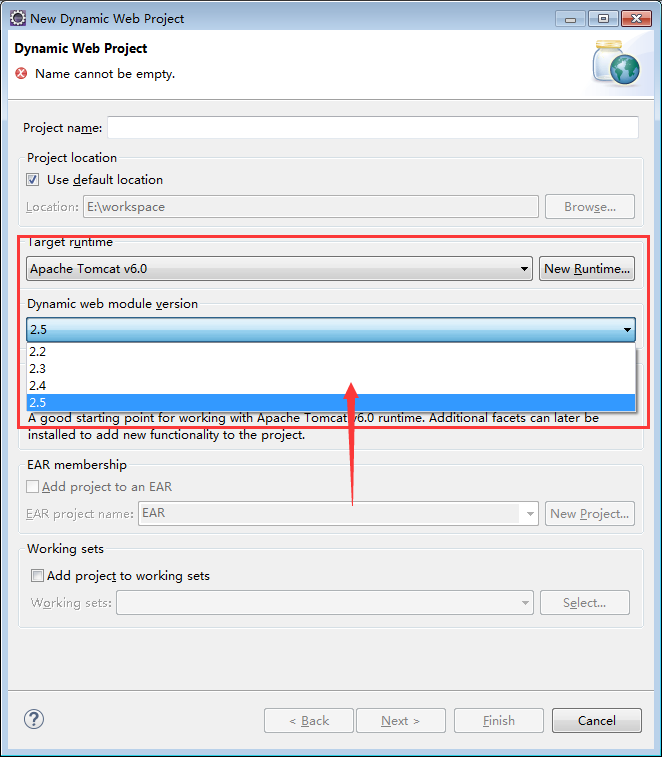
2 修改工程Servlet版本配置信息,文件为:工作目录\SessionExample\.settings\org.eclipse.wst.common.project.facet.core.xml
getAttribute与getParameter的区别
这部分是对JSP的扩展,经常在JSP或者Servlet中获取数据,那么getAttribute与getParameter有什么区别呢?
1 从获取到数据的来源来说:
getAttribtue获取到的是web容器中的值,比如:
我们在Servlet中通过setAttribute设定某个值,这个值存在于容器中,就可以通过getAttribute方法获取;
getParameter获取到的是通过http传来的值,比如这样一个http请求:
http:localhost:8080/test/test.html?username=xingoo
还有其他的GET和POST方式,都可以通过getParameter来获取。
2 从获取到的数据类型来说:
getAttribute返回的是一个对象,Object。
getParameter返回的是,前面页面中某个表单或者http后面参数传递的值,是个字符串。
参考
【1】慕课网,监听器:http://www.imooc.com/learn/271
【2】jsp中getAttribute与getParameter的区别:http://wenku.baidu.com/link?url=4URJWerrusLTFRviR1sAlTH4BKc7QswiRYsso3xaYs_nZMiTMV-TwCnIIgu31K1N9HbrUhfgO2-jXjpYe1hGZn9RBo3b8HHzY2Dn2-Fcbs7
http://www.cnblogs.com/xing901022/p/4378727.html